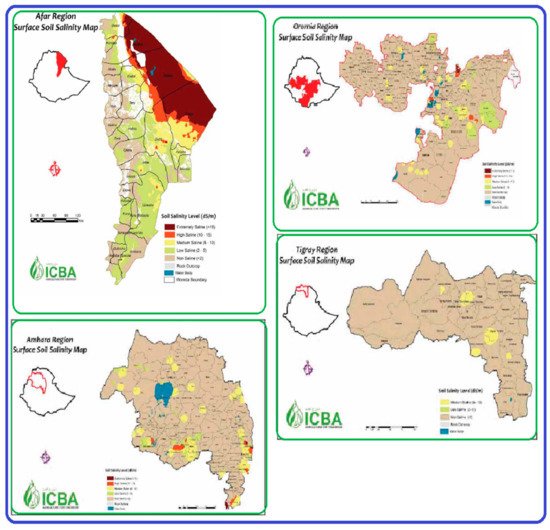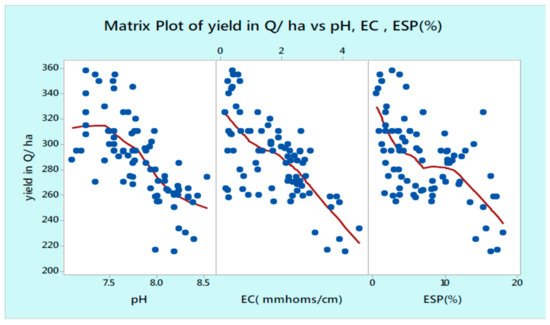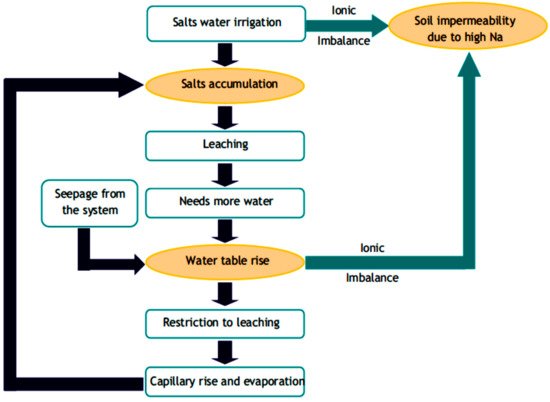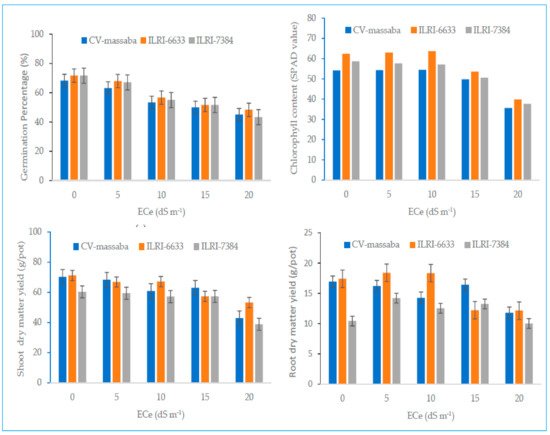You're using an outdated browser. Please upgrade to a modern browser for the best experience.
Please note this is a comparison between Version 2 by Vivi Li and Version 1 by Ashenafi Daba.
Ethiopia’s irrigated agriculture productivity has been threatened by severe salinity and sodicity problems which have resulted in significantly lower yields, food insecurity, and environmental degradation. The destructive effects of poor irrigation water management with the absence of drainage and anticipated future climate changes can accelerate the formation of salt-affected soil, potentially expanding the problem to currently unaffected regions.
- salt-affected soil
- soil amendment
- drainage management
- salt tolerant crop
- livelihood sustainability
1. Introduction
Globally, salt-affected soils are a severe problem in lowland irrigated areas because of inappropriate irrigation practices and poor water quality. Globally, about 20% of the irrigated lands are affected by salinity and sodicity problems [1]. In addition, the world is losing at least 10 ha of arable land every minute [2]; from this, 3 ha are lost due to salinity and sodicity problems, especially in lowland irrigated regions of the world. Accumulation of soluble salts is the single most important factor in the formation of salt-affected soils in the arid and semi-arid areas where evaporation exceeds precipitation. The sources of salts include saline parent materials particularly weathering of rocks and primary minerals, fossil salts of former marine and lacustrine deposits, atmospheric deposition, collection of saline sediments in catchment areas, irrigation waters and/or fertilization [3]. During the weathering process, both physical and chemical, salts are released from rocks and minerals of the Earth’s crust. In arid regions, salts are brought in by streams draining into the basins [1]. In sub-humid regions, dissolved sodium accumulates as exchangeable sodium, due to vertical or horizontal leaching. Salt-affected soils often occur on irrigated lands, especially in arid and semi-arid regions, where annual rainfall is insufficient to meet the evaporation needs of plants and leaching of salts [4]. In humid areas, soluble salts are carried down through the soil profile by percolating rainwater and ultimately are transported to sea.
The soluble salts that occur in salt-affected soils consist mostly of various proportions of Na+, Ca2+, Mg2+, Cl−, SO42−, HCO3− and occasionally K+, CO32− and NO3− ions with minor quantities of B, F and Li that are seldom of major importance because of their toxicity to plants [5]. These ionic constituents of salt-affected soils are released and made soluble from rocks and weatherable minerals during the processes of geochemical and pedochemical weathering. Four main sources of the constituents of soil salinity and sodicity {Na+, Ca2+, Mg2+, K+ (common metals) and SO42−, Cl−, HCO3−, NO3− (common ligands)} are (a) mineral weathering (Na rich feldspars), (b) precipitation or rainfall, (c) fossil salts (marine or lacustrine deposits) and (d) collection of saline sediments in catchment areas [1,5][1][5]. Salts may also be introduced in irrigation water, or because of fertilization.
Depending on the climatic conditions, the accumulated soluble salts may adequately be leached out of the profile in humid environments. However, in arid environments where ET exceeds rainfall during some periods of the year, removal of salts through rainfall is very low compared with the rate of their removal by irrigation water [4]. Therefore, the processes of secondary salinization in arid and semi-arid climatic regions are the consequences of quite diverse and interacting factors of surface and ground waters, soil physical properties, climate, relief and geomorphology, biological activities, and human interference [2].
Several researchers have reported the widespread occurrence of soil and water salinity and sodicity in the lowland irrigated areas of Ethiopia [3,4,5][3][4][5]. Ethiopia’s total land area affected by salinity is 11,033,000 ha, and it is ranked first in Africa [6]. Following Ethiopia are Chad, Egypt, and Nigeria, having a total area of 8,267,000, 7,360,000, and 6,502,000 ha of salt-affected lands, respectively [6].
Most of these areas are present in the rift valley, the Denakil Plains, Wabi Shebelle River Basin, and lowlands irrigated areas of the country [3]. The problem is aggravated due to inappropriate irrigation practices and lack of drainage schemes that resulted in rising groundwater levels (EC = 0.9–13.4 dSm−1) closer to the soil surface, making the farm areas susceptible to secondary salinization. Due to poor irrigation practices and high evapotranspiration rates, about 33% of the total area of the Amibara irrigation scheme became salt-affected (ECe = 4.03–65.71 dSm−1) within five to eight years [7]. Three leading causes for the development of salt-affected soils include primary or naturally induced salinity, secondary or human-induced, and their combination that is especially pronounced under ongoing climate change in water-scarce regions [3]. Soil salinity and sodicity reduce plant growth and affect soil properties by limiting water availability to plants; specific ions toxicity; imbalance plant nutrition; alteration of soil physical properties and effect composition and activity of beneficial soil microorganisms [3,8][3][8].
Salinity and sodicity is abiotic stress that hinders the growth of crops by limiting water and mineral take-ups, affecting human and animal health and the whole ecosystem [9,10][9][10]. Salt affected soils have incredible environmental, agricultural, ecological, and social impacts through reducing crop production and soil quality, resulting in unstable livelihood security, low economic returns, and poor quality of life [11]. Soil salinization has social consequences, including reduced agricultural product, low income, change of livelihood options, and related social constraints. This situation requires government support to reclaim salt-affected areas to avoid crop production and financial losses [12]. Farmers in salt-affected regions of the middle and lower awash basin are mostly resource-limited and require financial and technical support to sustain their livelihood efforts [5].
2. Cause and Type of Salt-Affected Soils
The common causes of soil salinity and sodicity are geological, hydrological, and pedological processes. Primary soil salinization is governed by; (i) seawater intrusion via upstream river flows and through underground porous geomorphological shoreline structures [14][13]; (ii) wind deposition of salts from saline and/or sodic water resources onto adjacent lands [15][14]; and (iii) in situ dissolution and substantial surface deposit of endogenous (parent) minerals [16][15].
The process of salinization in the Awash River Basin [17,18,19,20][16][17][18][19] of Ethiopia is somewhat more diverse and complicated. This is mainly because of the presence of residual or fossil salts of former alluvial, colluvial, lacustrine and/or marine deposits of the weathered products of the salt and sodium-rich primary minerals of igneous rocks originating from the volcanic regions of the central highlands and the rift valley system of the country [20][19]. The mineralized surface water and groundwater, inefficient irrigation practices, inadequate drainage systems, lowland areas, and arid climate or inadequate annual rainfall to leach down accumulated salts from the plant root zone are other significant causes (Figure 1). The criteria used to classify salt-affected soils is given in Table 1.
Table 1. Summary of classification of salt affected soils based on their chemical properties [22][21].
| Salt Affected Soil Type | Electrical Conductivity of Saturation Extracts (ECe) at 25 °C (dSm−1) | Saturation (%) of Cation Exchange Capacity with Na (ESP) | Reaction (pH Value) |
|---|---|---|---|
| Saline soil | >4 | <15 | <8.5 |
| Saline sodic soil | >4 | >15 | <8.5 |
| Sodic (alkali) soil | <4 | >15 | 8.5–10 |
| Non-saline non-sodic | <4 | <15 | About neutral |
Soils having soluble salts in solution and/or Na+ ions on exchange sites exceeding certain limits can adversely affect soil-plant health [23,24][22][23]. Salt-affected soils are classified into three categories: saline, saline-sodic, and sodic, mainly based on total soluble salts (EC) and sodium hazards (sodium adsorption ratio (SAR) or exchangeable sodium percentage (ESP) of a soil system. Overall rehabilitation and management of salt-affected soils depend on the classification of salt types [25][24], especially saline-sodic and sodic soils that need investment [26][25]. Generally, understanding the kind of salts is very dominant for the management and rehabilitation of salt-affected soils.
3. Extent and Distribution of Saline and Sodic Soils in Ethiopia
Ethiopia stands 9th in terms of total land and 7th in percent of the total salt-affected area among the various countries in the world. Despite the widespread existence of salt-affected soils, no accurate data and information is available on their extent, distribution, exact geographical location, sources, causes, and properties. However, many of these soils are concentrated in the plain lands of the lowland regions (Afar, Oromia and Amhara), Rift Valley System, the Denakil Plains, Wabi Shebelle River Basin, and various other lowlands and valley bottoms throughout the country [3,5][3][5]. Recently, salt-affected irrigated farmlands of four regions (Afar, Oromia, Amhara, and Tigray) of Ethiopia have been mapped using remote-sensing and soil data and the results are presented in Figure 2 and Table 2 [5].


Figure 2. Surface salinity classes (0–30 cm) of Afar, Amhara, Oromia, and Tigray regions of Ethiopia [5].
Table 2. Percentage of area coverages by salinity soils classes of Afar, Amhara, Oromia, and Tigray regions of Ethiopia [5].
| Soil Salinity Levels (dSm−1) |
Afar | Oromia | Amhara | Tigray | ||||
|---|---|---|---|---|---|---|---|---|
| Km2 | % | Km2 | % | Km2 | % | Km2 | % | |
| Non-saline (<2) | 40,787 | 42 | 287,768.25 | 88.70 | 137,428 | 88 | 48,067 | 97.29 |
| Low saline (2–5) | 26,961 | 28 | 17,292.05 | 5.33 | 4903 | 3 | 0 | 0 |
| Medium saline (5–10) | 9798 | 10 | 17,152.54 | 5.29 | 11,892 | 8 | 1339 | 2.71 |
| High saline (10–15) | 5618 | 5 | 1576.72 | 0.49 | 1230 | 0.8 | 0 | 0 |
| Extremely saline (>15) | 14,085 | 15 | 713.74 | 0.22 | 202 | 0.2 | 0 | 0 |
| Total area | 97,204 | 100 | 324,428.69 | 100 | 155,648 | 100 | 49,604 | 100 |
The total land covered by salt-affected soils in the former Hararghe Administrative Region alone is estimated to be 1,159,300 ha, which is about 12.9% of the arable land area in the Region [3]. In Amibara irrigated area (14,787.58 ha), 70% of the soils are Fluvisols and the rest 30% are Vertisols, with a coverage of about 33.20% and 8.76% of the total salt affected area, respectively [27][26]. Furthermore, reports have also indicated that 39% of the Abaya State Farm was salt affected [28][27]. The baseline survey results revealed that there are 119 and 10,000 ha of salinity and sodicity soils in the Tigray and Southern Nations, Nationalities, and the People Regional States, respectively [3].
The Rift Valley Zones and the south-eastern (Somali) lowlands are among the most valuable agricultural areas as they offer a considerable promise for multiple cropping. Most of the irrigated State Farms which produces export crops such as cotton, sugar cane, citrus fruits, banana, and vegetable crops are situated in the Rift Valley Zone and lower Wabi Shebelle basin of Gode. In these areas, small-scale cultivation with a canal irrigation system from the Shebelle River is introduced. Yet sizeable regions in this zone are being converted to salt-affected soils annually at an alarming rate [3,4,5,29][3][4][5][28].
The magnitudes of salt-affected soils are high to the extent that the establishment and growth of crops and other plants failed utterly. This implies that expansion of large-scale irrigation schemes in the Wabi Shebelle and other river basins without appropriate management of salts may result in further development of soil salinity and sodicity problems leading to complete loss of land value as experienced in the Awash River Basin in the Rift Valley [4,5,29,30][4][5][28][29]. Therefore, installation of adequate drainage systems in irrigated areas is a pre-condition for sustainable crop production.
4. Influence of Salt Affected Soils on Crop Production and Soil Productivity
4.1. Influence of Salt-Affected Soils on Crop Production
Plants in saline and sodic soils of arid regions grow in a predominantly delicate balance with their environment because the excessive presence of soluble salts and exchangeable sodium in these soils can negatively affect crop. Lack of proper management leads to reduced crop production or in severe cases complete crop failure followed by a decline in land value and subsequently made the land abandoned for agricultural use [31,32][30][31]. Salinity, therefore, adversely affects the seed germination, establishment of young seedlings, and plant growth by decreasing the ease with which they may take up water and nutrients from the soil solution [33][32]. The plants can die from water stress or drought in moist soil if the salt concentration develops high enough in the field [34,35][33][34]. Increasing salinity levels beyond threshold level of plants negatively affect crop yields [36,37,38][35][36][37]. The studies conducted in Ethiopia have shown that dry biomass yield and grain yield of five Quinoa genotypes is negatively affected by increasing salinity levels (Figure 3) [39][38].


Many researchers have indicated that the overall accumulation of salt in the plant root zone is a challenge to plant growth and development through increasing osmotic pressure of the soil solution; inducing ion toxicity and nutrient imbalance, and unfavored soil physical properties [31,32][30][31]. A yield reduction of 5% for broad bean and 20% for lentils were observed at an ECe of 2.0 dSm−1. When the salinity level was increased to 3.1 dSm−1, the corresponding yield reductions were 15% and 95%, respectively [3]. The high salinity causes reduction in the dry matter yield of Alfalfa and Rhodes grass while the leaf-to-stem ratio increases, affecting forage quality [40][39]. A matrix plot of onion yield showed a reduced trend as the soil’s pH, EC, and ESP increased [41][40]. In addition to this, increasing salt stress delayed the germination of Rhodes grass because higher salinity causes poor cell elongation resulting from reduced turgor, cell volume, and cell growth (Figure 4) [42][41]. Therefore, increasing salinity levels can decrease grain and biomass yield due to poor seed establishment [24,28,35][23][27][34].
4.2. Influence of Salt-Affected Soils on Soil Productivity
Salt-affected soils negatively influence the soil’s physical and chemical fertility, decreasing soil productivity [43][42]. Alteration of soil physical properties resulting from the swelling and dispersion of colloidal soil particles caused by the presence of excess sodium, and finally results in poor water and air circulation, water-holding capacity, restricted root penetration, and seedling development problems [32,33][31][32]. The sodicity increases with the bulk density because of the dispersive action of sodium on soil particles resulting in soil compaction, changing the pore size distribution, and decreasing the total volume of soil [24][23]. The increased soil sodium content affect the aggregation stability, thereby promoting clay from dispersing [8]. Second, the extent of exchangeable sodium percentage results in poor aggregation effects on bulk density, hydraulics conductivity, and mean weight diameter, which seriously affected crop productivity (Figure 5 and Figure 6).




The possible mechanisms responsible for the reduced permeability and aeration of alkali soils are the swelling and dispersion of clay and organic matter particles and their migration, causing the clogging of soil pores. As a rule, the swelling and dispersion of colloidal soil particles attributed to the presence of high exchangeable sodium results in restricted water infiltration and movement, limited air movement (aeration property), reduced root penetration, and increased crust formation as to decrease the emergence of seedlings. This mainly affects the inhabitants, structure, and activity of beneficial soil microorganisms through the osmotic effects of soluble salts or toxicity of specific ions of such soils. Therefore, some effects of salts on microbial processes will have large suggestions for SOM dynamics, ecosystem biogeochemical cycling, and plant nutrition [45,46][44][45].
References
- FAO. Status of the World’s Soil Resources (SWSR)–Main Report; Food and Agriculture Organization of the United Nations and Intergovernmental Technical Panel on Soils: Rome, Italy, 2015; 650p.
- Mustafa, M.A. Desertification Processes; UNESCO Chair of Desertification/University of Khartoum: Khartoum, Sudan, 2007.
- Levy, G.J.; Goldstein, D.; Mamedov, A.I. Saturated Hydraulic Conductivity of Semiarid Soils: Combined Effects of Salinity, Sodicity, and Rate of Wetting. Soil Sci. Soc. Am. J. 2005, 69, 653–662.
- Sileshi, A.A.; Kibebew, K. Status of Salt Affected Soils, Irrigation Water Quality and Land suitability of Dubti/Tendaho Area, Northeastern Ethiopia. Doctoral Thesis, Haramaya University, Haramaya, Ethiopia, 2016.
- Qureshi, A.S.; Tesfaye, E.M.; Melese, M.G. Extent Characterization and Management Strategies for the Salt Affected Soils in Ethiopia; Project Report, No. 2; Dubai, United Arab Emirates, 2020; p. 94. Available online: https://www.researchgate.net/publication/340362011_EXTENT_CHARACTERIZATION_AND_MANAGEMENT_STRATEGIES_FOR_THE_SALT-AFFECTED_SOILS_IN_ETHIOPIA?channel=doi&linkId=5e84cf8ca6fdcca789e641b0&showFulltext=true (accessed on 6 December 2021).
- Abrol, I.P.; Yadav, J.S.P.; Massoud, F.I. Soil Resources, Management and Conservation Service. In Salt-Affected Soils and Their Management; FAO: Rome, Italy, 1988; Volume 5, p. 14.
- Halcrow, W. Water management manual. Amibara irrigation project. In Water Resource Development in Ethiopia; Forum for Social Studies: Addis Ababa, Ethiopia, 1983.
- Chatterjee, A.; Geaumont, B.; DeSutter, T.; Hopkins, D.G.; Rakkar, M. Rapid shifts in soil organic carbon mineralization within sodic landscapes. Arid L. Res. Manag. 2015, 29, 255–263.
- Rengasamy, P. World salinization with emphasis on Australia. J. Exp. Bot. 2006, 57, 1017–1023.
- Brady, N.C.; Weil, R.R.; Weil, R.R. The Nature and Properties of Soils; Prentice Hall: Upper Saddle River, NJ, USA, 2008; Volume 13.
- Wondim, G.B.; Daba, A.W.; Qureshi, A.S. Effects of Salinity on Producers’ Livelihoods and Socio-economic Conditions; the Case of Afar Region, Northeastern Ethiopia. J. Sustain. Agric. Sci. 2020, 46, 35–46.
- Abebe, F.; Alamirew, T.; Abegaz, F. Appraisal and mapping of soil salinity problem in amibara irrigation Farms, middle awash basin, Ethiopia. Int. J. Innov. Sci. Res. 2015, 13, 298–314.
- Franceschini, F.; Signorini, R. Seawater intrusion via surface water vs. deep shoreline salt-wedge: A case history from the Pisa coastal plain (Italy). Groundw. Sustain. Dev. 2016, 2, 73–84.
- Ondrasek, G.; Rengel, Z. Environmental salinisation processes: Detection, implications & solutions. Sci. Total Environ. 2020, 754, 142432.
- Biggs, A.J.W.; Watling, K.M.; Cupples, N.; Minehan, K. Salinity risk assessment for the Queensland Murray–Darling Region. Queensl. Dep. Environ. Resour. Manag. Toowoomba 2010, 3, 125.
- Gebrekidan, H. Investigation on Salt Affected Soils and Irrigation Water Quality in Melka Sedi-Amibara Plain, Rift Valley Zone of Ethiopia. Master’s Thesis, Addis Ababa University, Addis Ababa, Ethiop, 1985; 132p.
- Gebrekidan, H. Problems and Prospects of Salt Affected Soils in Ethiopia (Summary Literature Survey Report); AUA, Department of Plant Science: Iera Odos, Greece, 1987; 17p.
- Gebrekidan, H. Evaluation of the Potential Use of Langbeinite (K2SO4. 2MgSO4) as a Reclaiming Material for Sodic and Saline Sodic Soils. Ph.D. Thesis, The University of Arizona, Tucson, AZ, USA, 1995.
- Gebrekidan, H.; Mishra, B.B. Salt Affected Soils of Middle Awash River Basin of Ethiopia: Appraisal, Characterization and Classification. Geoderma 2005, 15, 7–15.
- Shahid, S.A.; Abdelfattah, M.A.; Omar, S.A.S.; Harahsheh, H.; Othman, Y.; Mahmoudi, H. Mapping and Monitoring of Soil Salinization Remote Sensing, GIS, Modeling, Electromagnetic Induction and Conventional Methods–Case Studies. In Proceedings of the International Conference on Soils and Groundwater Salinization in Arid Countries, Muscat, Oman, 11–14 January 2010; Volume 59, p. 97.
- Richards, L.A. Diagnosis and Improvement of Saline and Alkali Soils; US Department of Agriculture: Washington, DC, USA, 1954.
- Gharaibeh, M.A.; Eltaif, N.I.; Albalasmeh, A.A. Reclamation of highly calcareous saline sodic soil using Atriplex halimus and by-product gypsum. Int. J. Phytoremediation 2011, 13, 873–883.
- Zaman, M.; Shahid, S.A.; Heng, L. Guideline for Salinity Assessment, Mitigation and Adaptation Using Nuclear and Related Techniques; Springer Nature: Basingstoke, UK, 2018; ISBN 331996190X.
- Gupta, M.; Srivastava, P.K.; Niranjan, A.; Tewari, S.K. Use of a bioaugmented organic soil amendment in combination with gypsum for Withania somnifera growth on sodic soil. Pedosphere 2016, 26, 299–309.
- Mishra, V.K.; Jha, S.K.; Damodaran, T.; Singh, Y.P.; Srivastava, S.; Sharma, D.K.; Prasad, J. Feasibility of coal combustion fly ash alone and in combination with gypsum and green manure for reclamation of degraded sodic soils of the Indo-Gangetic Plains: A mechanism evaluation. L. Degrad. Dev. 2019, 30, 1300–1312.
- Worku, A.; Bedadi, B. Studies on soil physical properties of salt affected soil in Amibara area, central rift valley of Ethiopia. Int. J. Agric. Sci. Nat. Resour. 2016, 3, 8–17.
- Asfaw, K.G.; Itanna, F. Screening some tef accessions/varieties for salt tolerance during germination and seedling stage. Momona Ethiop. J. Sci. 2009, 1, 17–29.
- Tsegaye, G. Surface Water-Groundwater Interactions and Effects of Irrigation on Water and Soil Resources in the Awash Valley; AAU Institutional Repository: Addis Ababa, Ethiopia, 2009.
- Mohammed, H.; Mishra, B.B. Soils of Jijiga and Gode Research Centers; AAU Institutional Repository: Addis Ababa, Ethiopia, 2005.
- Mesfin, A. Irrigation for Sustainable Agricultural Development in Ethiopia, Ethiop. J. Agric. Sci. 2015, 25, 31–44.
- Mintesinot, D. Salt Affected Soils in Dire Dawa, Ethiopia. A Characterization and Classification MSc; Haramaya University: Haramaya, Ethiopia, 2020.
- Ganjegunte, G.K.; Sheng, Z.; Clark, J.A. Soil salinity and sodicity appraisal by electromagnetic induction in soils irrigated to grow cotton. L. Degrad. Dev. 2014, 25, 228–235.
- Nekir, B. Effect of Organic Matter on Rice Nitrogen and Phosphorus Use Efficiency Under Calcareous Sodic Soil of Amibara District, Ethiopia. J. Agric. Crop. 2019, 5, 178–185.
- Beakal, T.; Hussein, M.; Alemayehu, A. The effect of salinity on germination, vegetative and final growth stage of different rice (Oryza sativa L.) genotypes. J. Anim. Plant Sci. 2016, 29, 4651–4664.
- Fageria, N.K.; Gheyi, H.R.; Moreira, A. Nutrient bioavailability in salt affected soils. J. Plant Nutr. 2011, 34, 945–962.
- Fallovo, C.; Rouphael, Y.; Rea, E.; Battistelli, A.; Colla, G. Nutrient solution concentration and growing season affect yield and quality of Lactuca sativa L. var. acephala in floating raft culture. J. Sci. Food Agric. 2009, 89, 1682–1689.
- Chinnusamy, V.; Jagendorf, A.; Zhu, J. Understanding and improving salt tolerance in plants. Crop Sci. 2005, 45, 437–448.
- Qureshi, A.S.; Daba, A.W. Differential analysis of five quinoa (Chenopodium quinoa W.) genotypes under different salt stresses in a controlled environment. Am. J. Sustain. Agric. 2019, 13, 1–17.
- Gelaye, K.K.; Zehetner, F.; Loiskandl, W.; Klik, A. Comparison of growth of annual crops used for salinity bioremediation in the semi-arid irrigation area. Plant Soil Environ. 2019, 65, 165–171.
- Kitila, K.; Chala, A.; Workina, M. Effect of Gypsum and compost Application in Reclaiming Sodic soils at Small Scale Irrigation Farm in Bora District of East Shewa Zone, Oromia, Ethiopia. Agriways 2020, 8, 28–44.
- Daba, A.W.; Qureshi, A.S.; Nisaren, B.N. Evaluation of some rhodes grass (Chloris gayana) genotypes for their salt tolerance, biomass yield and nutrient composition. Appl. Sci. 2019, 9, 143.
- Farifteh, J.; Farshad, A.; George, R.J. Assessing salt-affected soils using remote sensing, solute modelling, and geophysics. Geoderma 2006, 130, 191–206.
- Shirale, A.O.; Kharche, V.K.; Wakode, R.R.; Meena, B.P.; Das, H.; Gore, R.P. Influence of gypsum and organic amendments on soil properties and crop productivity in degraded black soils of Central India. Commun. Soil Sci. Plant Anal. 2018, 49, 2418–2428.
- Setia, R.; Marschner, P.; Baldock, J.; Chittleborough, D. Is CO2 evolution in saline soils affected by an osmotic effect and calcium carbonate? Biol. Fertil. Soils 2010, 46, 781–792.
- Setia, R.; Smith, P.; Marschner, P.; Gottschalk, P.; Baldock, J.; Verma, V.; Setia, D.; Smith, J. Simulation of salinity effects on past, present, and future soil organic carbon stocks. Environ. Sci. Technol. 2012, 46, 1624–1631.
More


